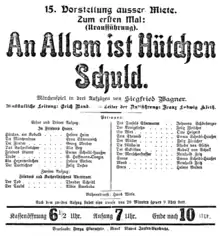An allem ist Hütchen schuld!
An allem ist Hütchen schuld! ('Hattie is to blame for everything!'), Op. 11, is an opera in German in three acts composed by Siegfried Wagner in 1914/15 to his own libretto. It is described as a Märchenspiel or fairy-tale play. It premiered on 6 December 1917 at the court theatre (Hoftheater) in Stuttgart.
| An allem ist Hütchen schuld! | |
|---|---|
| Opera by Siegfried Wagner | |
 List of the cast of the premiere | |
| Description | Märchenspiel |
| Translation | Everything is to blame for Hats! |
| Librettist | Siegfried Wagner |
| Language | German |
| Based on | fairy-tales by the Brothers Grimm |
| Premiere | |
History
Siegfried Wagner, the son of Richard Wagner, composed several operas on fairy tale and legendary topics. He began the composition of An allem ist Hütchen schuld! in September 1914. He finished a draft for the first act on 22 September and its score in November that year, a draft for the second act on 10 January 1915 and its score on 12 April, and the draft for the third act on 11 June, completing the opera on 26 August 1915.[1] He wrote the libretto based on several episodes from fairy-tales by the Brothers Grimm.[1]
The premiere was at the Hoftheater Stuttgart on 6 December 1917, staged by Franz Ludwig Hörth and conducted by Erich Band.[1][2] It was a success with the public comparable to his Der Bärenhäuter.[2] The opera was performed again in Halle in 1929, staged by Heinrich Kreutz and conducted again by Band. A production in Leipzig in 1939 was directed by Wolfram Humperdinck in a stage set by Wieland Wagner and conducted by Gilbert of Gravina. A production in Altenburg in 1944 was also shown in Bayreuth, directed by Wieland Wagner, conducted by Kurt Overhoff and with choreography by Gertrud Wagner.[1]
After World War II, the opera was not played. The first complete production was in 1997 at the Theater Hagen, staged by Peter P. Pachl and conducted by Gerhard Markson.[3][4][5] The opera was played once at the AudiMax of the Ruhr University Bochum on 18 October 2015, again staged by Pachl, with Lionel Friend conducting the Bochumer Symphoniker.[6][7]
Roles
| Role | Voice type | Premiere cast, 6 December 1917[1][8] |
|---|---|---|
| Hütchen | soprano | Helene Heim |
| Märchenfrau | soprano | Erna Ellmenreich |
| Katherlies’chen | soprano | Else Betz |
| Frieder | tenor | George Maeder |
| Frieder's Mutter / Wirtsfrau / Sonne | mezzo-soprano | Emma Scheidl-Haußer |
| Trude | contralto | Siegfried Onegin |
| Hexenweibchen / Stern | coloratura soprano | Helene Berden |
| Dorfrichter | tenor | Felix Decken |
| Tod | baritone | Theodor Scheidl |
| Teufel | bass | Albin Swoboda |
| Des Teufels Ellermutter | mezzo-soprano | Johanna Schönberger |
| Königssohn | baritone | Felix Fleischer |
| Müller | bass | Felix Fleischer |
| Wirt | baritone | Otto Helgers |
| Müllerin | soprano | Roda von Glehn |
| Sakristan | tenor | Rudolf van Schaik |
| Menschenfresser / Mond | bass | Reinhold Fritz |
| Das singende, springende Löweneckerchen | soprano | |
| Jacob Grimm, Siegfried Wagner | speaking roles | |
Fairy tales
Wagner used elements from many fairy tales in his libretto, including:[2]
- Frederick and Catherine (Der Frieder und das Katherlieschen)
- The Three Little Men in the Wood (Die drei Männlein im Walde)
- The Singing, Springing Lark (Das singende springende Löweneckerchen)
- The Clever Little Tailor (Vom klugen Schneiderlein)
- The Devil with the Three Golden Hairs (Der Teufel mit den drei goldenen Haaren)
- The Devil and his Grandmother (Der Teufel und seine Großmutter)
- The Seven Ravens (Die sieben Raben)
- Death's Messengers (Die Boten des Todes)
- Godfather Death (Der Gevatter Tod)
- The Wishing-Table, the Gold-Ass, and the Cudgel in the Sack (Tischchen deck dich, Goldesel und Knüppel aus dem Sack)
- The Little Peasant (Das Bürle)
- Allerleirauh
- The Two Kings' Children (De beiden Künigeskinner)
- The Iron Stove (Der Eisenofen)
- The True Bride (Die wahre Braut)
- Rapunzel
- The Two Brothers (Die zwei Brüder)
- Little Claus and Big Claus (Der kleine Klaus und der große Klaus) by Hans Christian Andersen
References
- "An allem ist Hütchen schuld! Op. 11 – Siegfried Wagner" (in German). wagnerportal.de. Archived from the original on 2017-03-04. Retrieved 7 March 2017.
- Pachl, Peter P. (2015). "Und was du da wieder aufgebaut: Vierzig Märchen zusammengebraut!" – oder: "Wollt ihr den totalen Grimm?". Siegfried Wager zum 85. Todestag (in German). Internationalen Siegfried Wagner Gesellschaft. pp. 20ff.
- Bahr, Achim (2015). Das Schweigen der Kröte. Program book (in German). Bochum. pp. 31ff.
- Gier, Albert (2015). Kreuz und quer durchs Märchenland. Program book (in German). Bochum. pp. 23ff.
- Schmöe, Stefan (1997). "An allem ist Hütchen schuld" (in German). Online Musik Magazin. Retrieved 29 October 2015.
- Kampe, Gordon (2015). "Grimm und Käse – "An allem ist Hütchen schuld" im Audimax Bochum" (in German). NMZ. Retrieved 28 October 2015.
- Rosén, Friedeon (2015). "Bochum/ Audimax: An allem ist Hütchen schuld" (in German). Online Merker. Retrieved 28 October 2015.
- "An allem ist Hütchen schuld!" (in German). Bayreuth: Internationale Siegfried Wagner Gesellschaft. Retrieved 7 March 2017.
External links
- An allem ist Hütchen schuld! AllMusic
- Der Komponist Siegfried Wagner – Der Gralshüter von Bayreuth als Komponist von Märchenopern (in German) treatise
- Siegfried Wagner / An allem ist Hütchen schuld! / Op. 11 (1915) (libretto] Siegfried Wagner Gesellschaft